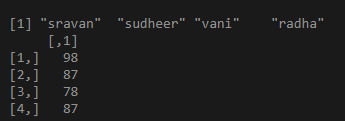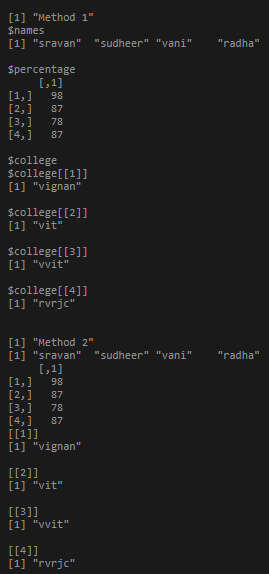从 R 中的列表中提取列
在本文中,我们将创建一个元素列表并在 R 中访问这些列。我们首先创建一个包含矩阵和向量的列表,然后使用 R 访问这些列。
方法
- 创建列表
句法:
list_name=list(var1, var2, varn..)
- 为列表元素分配名称作为列名称。我们可以使用 names()函数命名
句法:
names(list_name)=c(var1, var2, varn)
- 访问这些列和元素。
简单清单
方法 1:使用索引
在此方法中,我们只需传递具有列表名称的列的索引即可提取该特定列。
例子:
R
# Create a list that can hold a vector, and a matrix
list1 <- list(c("sravan", "sudheer", "vani", "radha"),
matrix(c(98, 87, 78, 87)))
# assign names to the elements in the list.
names(list1) <- c("names", "percentage")
# access the column 1
print(list1[1])
# access the column 2
print(list1[2])R
# Create a list that can hold a vector, and a matrix
list1 <- list(c("sravan", "sudheer", "vani", "radha"),
matrix(c(98, 87, 78, 87)))
# assign names to the elements in the list.
names(list1) <- c("names", "percentage")
# access the column 1
print(list1$names)
# access the column 2
print(list1$percentage)R
# Create a list that can hold a vector, and a matrix and a list
list1 <- list(c("sravan", "sudheer", "vani", "radha"),
matrix(c(98, 87, 78, 87)),
list('vignan', 'vit', 'vvit', 'rvrjc'))
# assign names to the elements in the list.
names(list1) <- c("names", "percentage", "college")
print("Method 1")
# access the column 1
print(list1[1])
# access the column 2
print(list1[2])
# access the column 3
print(list1[3])
print("Method 2")
# access the column 1
print(list1$names)
# access the column 2
print(list1$percentage)
# access the column 3
print(list1$college)R
# Create a list that can hold a vector, and a
# matrix and a list
list1 <- list(c("sravan", "sudheer", "vani", "radha"),
matrix(c(98, 87, 78, 87)),
list('vignan', 'vit', 'vvit', 'rvrjc'))
# access 2nd column first element
print(list1[[2]][[1]])
# access 2nd column
print(list1[[2]])
# access 3rd column third element
print(list1[[3]][[3]])输出:

方法二:使用 $运算符。
在此方法中,要检索的列的名称必须与其名称和列表名称一起传递,并以美元符号 ($) 分隔。
句法:
list_name$column_name
例子:
电阻
# Create a list that can hold a vector, and a matrix
list1 <- list(c("sravan", "sudheer", "vani", "radha"),
matrix(c(98, 87, 78, 87)))
# assign names to the elements in the list.
names(list1) <- c("names", "percentage")
# access the column 1
print(list1$names)
# access the column 2
print(list1$percentage)
输出:

具有不同结构的列表
列表可以包含矩阵、向量和列表作为列表的参数,但访问它们的方法保持不变,并且已在下面的代码中进行了讨论。
例子:
电阻
# Create a list that can hold a vector, and a matrix and a list
list1 <- list(c("sravan", "sudheer", "vani", "radha"),
matrix(c(98, 87, 78, 87)),
list('vignan', 'vit', 'vvit', 'rvrjc'))
# assign names to the elements in the list.
names(list1) <- c("names", "percentage", "college")
print("Method 1")
# access the column 1
print(list1[1])
# access the column 2
print(list1[2])
# access the column 3
print(list1[3])
print("Method 2")
# access the column 1
print(list1$names)
# access the column 2
print(list1$percentage)
# access the column 3
print(list1$college)
输出:

可以使用 [[]]运算符访问嵌套元素。
句法:
list_name[[value]][[value]]…
例子:
电阻
# Create a list that can hold a vector, and a
# matrix and a list
list1 <- list(c("sravan", "sudheer", "vani", "radha"),
matrix(c(98, 87, 78, 87)),
list('vignan', 'vit', 'vvit', 'rvrjc'))
# access 2nd column first element
print(list1[[2]][[1]])
# access 2nd column
print(list1[[2]])
# access 3rd column third element
print(list1[[3]][[3]])
输出:
